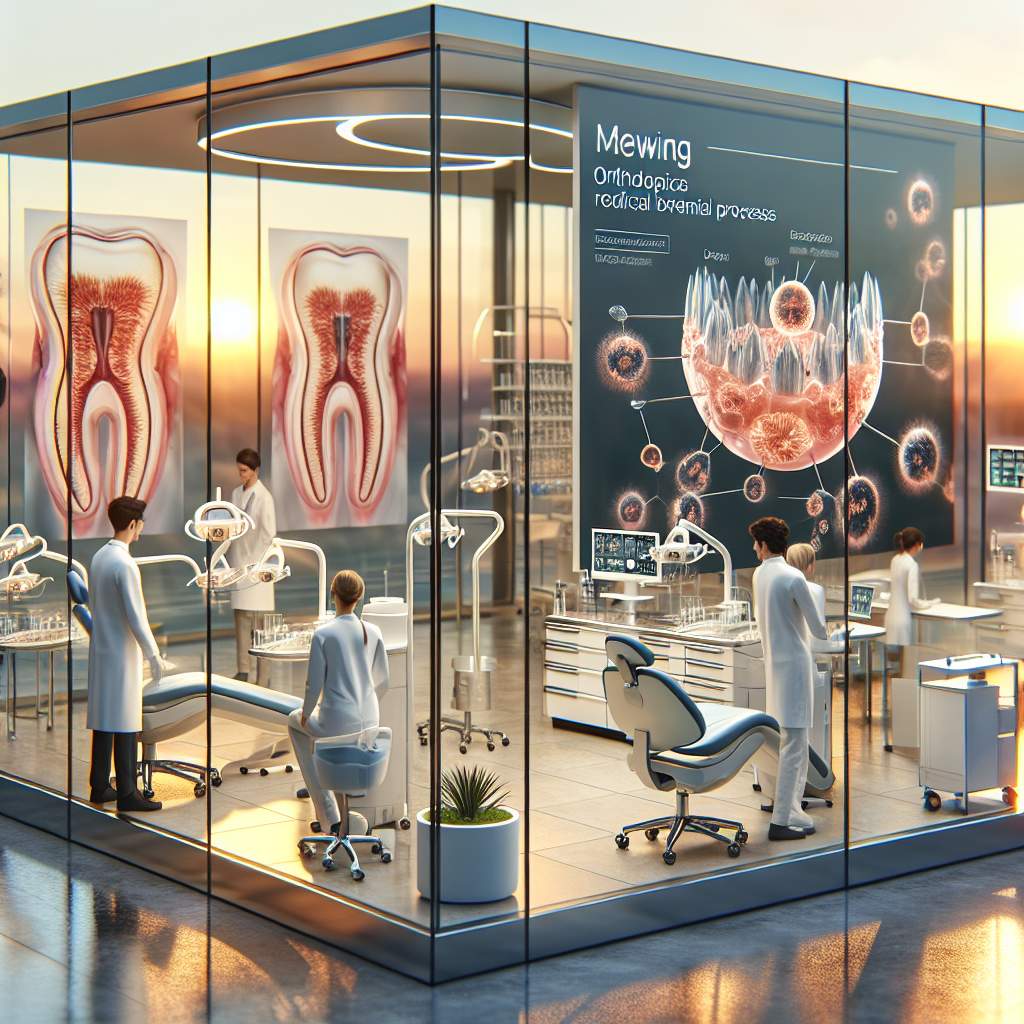What biochemical processes are involved in mewing?
Mewing, a technique focused on tongue posture to potentially reshape the jawline, does not directly trigger specific biochemical processes. Instead, it may influence bone remodeling through mechanical stress and pressure applied by proper tongue positioning. This process involves osteoblasts and osteoclasts, cells responsible for bone formation and resorption, respectively. These cellular activities are part of the body’s natural response to physical forces, rather than direct biochemical reactions initiated by mewing.

How Does Mewing Influence Jaw Development?
Mewing is a technique that some people believe can help shape the jaw and face. It involves placing the tongue against the roof of the mouth and keeping it there as much as possible. This action is thought to change how the jaw grows, especially in younger people whose bones are still developing.
When you practice mewing, you’re using your muscles in a way that they’re not used to. Over time, this can potentially lead to changes in how your jaw looks. Some folks say their jaws have become more defined or that their faces look better overall because of mewing. However, it’s important to remember that everyone’s body reacts differently, so what works for one person might not work for another.
What Are the Key Biochemical Processes Triggered by Mewing?
Mewing might seem like just moving your tongue around, but it actually can trigger some interesting processes inside your body. For starters, when you press your tongue against the roof of your mouth consistently, it can affect blood flow and muscle function in that area. This could lead to changes over time if done regularly.
Also, keeping your tongue in this position might influence how certain hormones are released in your body. These hormones could play a role in bone growth and development. So, while mewing seems simple on the surface, it could be doing more beneath the surface than we realize.
How Does Mewing Affect Facial Muscle Tone and Structure?
Mewing doesn’t just potentially impact your jawline; it might also have effects on your facial muscles and structure. By maintaining proper tongue posture, you’re engaging muscles around your face and neck that might not get much action otherwise. Over time, this could help tone these muscles, making them stronger and possibly changing the appearance of your face.
This toning effect could lead to a more defined facial structure for some people. Again, results will vary from person to person based on factors like age, genetics, and how consistently they practice mewing. But for those who do see changes, it could mean a sharper jawline or more pronounced cheekbones.
Can Mewing Alter Salivary Gland Function and Oral Microbiome?
Besides affecting muscle tone and bone structure, mewing might also have an impact on salivary gland function and the oral microbiome—the community of bacteria living in our mouths. Proper tongue posture can stimulate saliva production because it encourages regular swallowing movements. Saliva is super important for breaking down food and keeping our mouths healthy by washing away bacteria.
Speaking of bacteria, changing how our mouths move with mewing could shift which microbes thrive there. A healthy oral microbiome is key to preventing tooth decay and gum disease since certain types of bacteria can protect against harmful ones. So while we need more research to understand these effects fully, mewing could be influencing our oral health in ways we haven’t fully appreciated yet.
| Reaction Type | Triggered By Mewing | Potential Biochemical Impact |
|---|---|---|
| Mechanotransduction | Pressure from tongue against palate | Activation of signaling pathways that may influence bone remodeling |
| Osteogenic Differentiation | Continuous mechanical stress | Promotion of osteoblast differentiation, potentially affecting jawbone structure |
| Blood Flow Increase | Improved posture and respiratory function | Enhanced nutrient and oxygen delivery to facial tissues and muscles |
| Lymphatic Drainage Improvement | Better oral posture and muscle tone | Reduction in facial puffiness, potentially influencing facial aesthetics over time |
| Collagen Production Stimulation | Mechanical stress and improved circulation | |
| Hormonal Responses | ||
| Fibroblast Activity |
What Role Do Collagen and Elastin Play in Mewing Results?
Collagen and elastin are very important for mewing results. They are proteins in our skin that make it strong and stretchy. When you practice mewing, these proteins help your jawline become more defined. This is because they keep the skin tight and flexible.
As we get older, we lose some collagen and elastin. But mewing can help slow this down a bit. By pushing your tongue against the roof of your mouth, you’re also helping to keep these proteins active. This means your face can look younger for longer.
How Does Bone Remodeling Work in the Context of Mewing?
Bone remodeling is a process where your bones change shape over time. With mewing, this happens because you’re putting gentle pressure on your jawbone. This pressure tells your body to make changes there. It’s like telling your bones to move in a new way.
This doesn’t happen overnight, though. It takes a lot of time and consistent effort with mewing to see changes. Your body slowly adjusts the bone structure under your skin, which can lead to a sharper jawline and better alignment of your teeth.
Are There Any Hormonal Changes Associated with Consistent Mewing Practice?
Some people think that mewing might cause hormonal changes in the body. The idea is that by improving posture and breathing, mewing could affect hormones related to stress and relaxation. For example, better breathing might lower stress hormones like cortisol.
However, there’s not much scientific proof yet that shows a direct link between mewing and big hormonal changes. What we do know is that feeling good about how you look can boost confidence. And when we feel confident, our body releases positive hormones like serotonin.
Final Thoughts
Mewing is more than just a simple exercise; it’s about making small changes over time that add up. By understanding how collagen, elastin, bone remodeling, and possibly even hormonal changes play into it, you can see why consistency is key.
If you stick with it, mewing might help improve not just how your jaw looks but also how you feel overall. Remember though, patience is important because these changes take time to show up.






